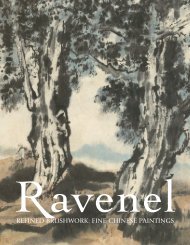亞洲現代與當代藝術 Modern and Contemporary Asian Art
羅芙奧2018春季拍賣會 亞洲現代與當代藝術 Ravenel Spring Auction 2018 Modern and Contemporary Asian Art
羅芙奧2018春季拍賣會 亞洲現代與當代藝術 Ravenel Spring Auction 2018 Modern and Contemporary Asian Art
You also want an ePaper? Increase the reach of your titles
YUMPU automatically turns print PDFs into web optimized ePapers that Google loves.
YOSHITOMO<br />
NARA<br />
MONKEY<br />
BABY GO-GO<br />
<br />
<br />
<br />
<br />
<br />
<br />
1988<br />
19931990<br />
<br />
<br />
<br />
<br />
<br />
<br />
<br />
<br />
<br />
<br />
<br />
<br />
<br />
<br />
<br />
"Monkey Baby Go-Go" displays many of the elements of<br />
Yoshitomo Nara's work which has brought him critical acclaim <strong>and</strong><br />
a world-wide cult following. Nara often depicts small children with<br />
big heads <strong>and</strong> large eyes, which at first glance seem cute <strong>and</strong><br />
benevolent, but as the viewer dwells on the child, they seem to be<br />
filled with angst <strong>and</strong> almost hatred, as their eyes reveal something<br />
uneasy.<br />
Nara's artwork like many contemporary Japanese artists is<br />
influenced by the style of anime <strong>and</strong> manga. Having graduated<br />
from the Aichi Prefectural University of Fine <strong>Art</strong>s <strong>and</strong> Music, he<br />
based himself in Tokyo, where he encountered a generation that<br />
has lost its way, wondering what its place in the world is, <strong>and</strong> as<br />
adults are bewildered <strong>and</strong> sociopathic. He spent five years in<br />
Germany studying at the Kunstakademie Dusseldorf from 1988 to<br />
1993. Returning to Japan in the early 1990s he was influenced by<br />
the Japanese Pop art movement or "Superflat" style as defined<br />
by Takashi Murakami. His figures are stylized in the manga form,<br />
however they are infused with great emotional power <strong>and</strong> impact.<br />
Using simple lines <strong>and</strong> empty backgrounds, Nara focuses our<br />
attention on his characters. Growing up, he was attracted to punk<br />
rock music, the outlet for an unhappy, disillusioned <strong>and</strong> aggravated<br />
youth.<br />
"Monkey Baby Go-Go" depicts an apparently happy child, dancing<br />
with himself. The yellow background color is bright <strong>and</strong> warm <strong>and</strong><br />
the child seems happy in himself. However, he is alone, <strong>and</strong> while<br />
seemingly independent, as we focus on his eyes we see a hardness<br />
that we don't expect in a child. It is this "aloneness" that so many<br />
Japanese suffered in Nara's generation, that he so powerfully<br />
depicts in this portrait. Children need to be surrounded by people,<br />
being loved <strong>and</strong> taken care of, <strong>and</strong> if these essential necessities<br />
are missing, the child's inner wellbeing suffers enormously.The<br />
title "Monkey Baby" makes us smile when we first hear it, with<br />
its connotations of childish play, but for many of Japan's current<br />
generation their upbringing lacked the love <strong>and</strong> attention that<br />
human children need, <strong>and</strong> for many of them, including Nara, they<br />
may feel that they were treated as little more than non-human<br />
monkeys. It is Nara's ability to portray so powerfully the inner<br />
turmoil of his generation that has brought him so many accolades<br />
<strong>and</strong> a huge worldwide following.







